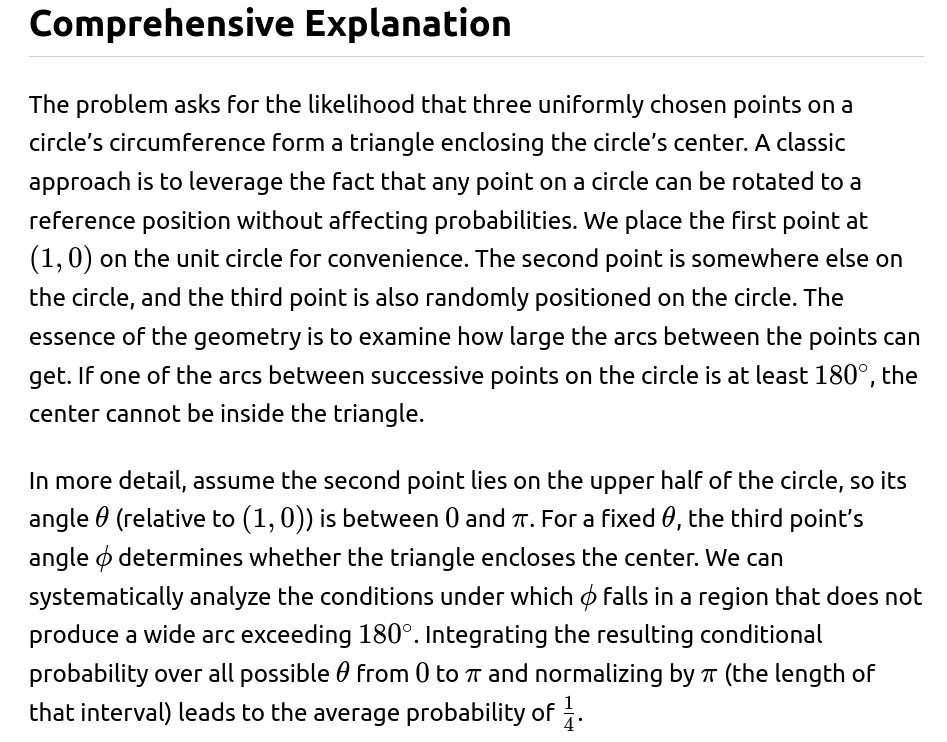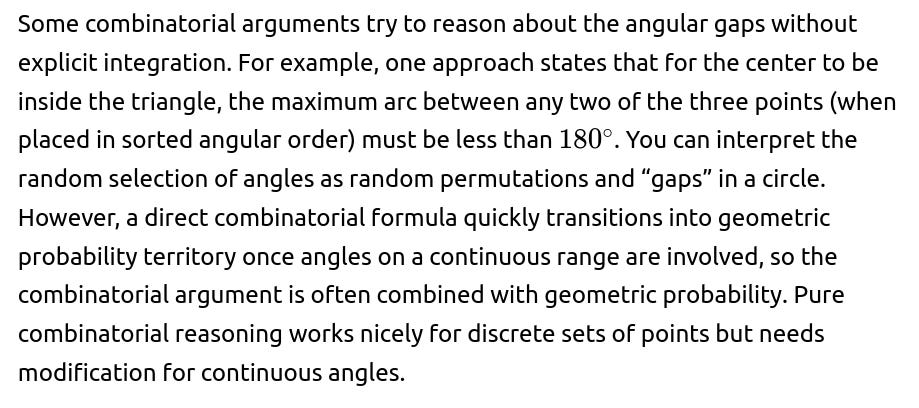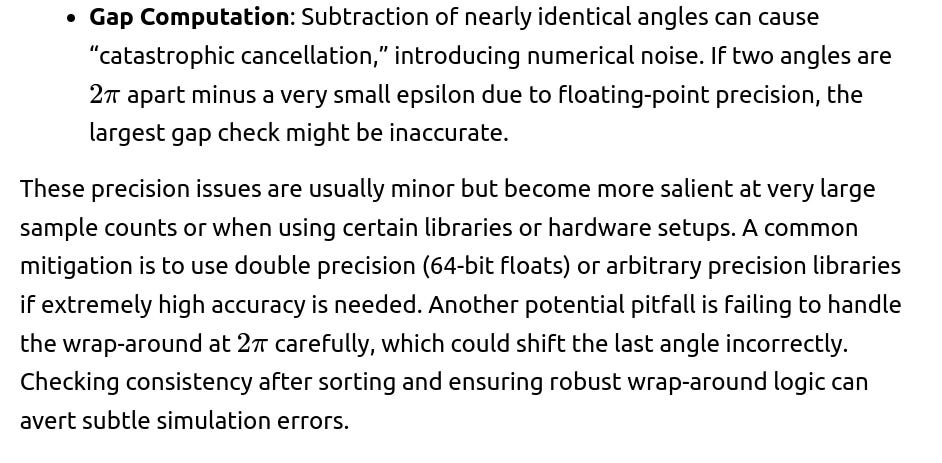ML Interview Q Series: Geometric Probability: Center Inside Random Triangle on Circle's Edge
Browse all the Probability Interview Questions here.
Three points are chosen at random on the edge of a unit circle and then used to form a triangle. What is the probability that the circle’s center lies inside that triangle?
import numpy as np
def simulate_triangle_center_inclusion(num_samples=10_000_000):
count_inside = 0
for _ in range(num_samples):
# Pick three angles uniformly
angles = np.random.uniform(0, 2*np.pi, 3)
angles.sort()
# Check the largest gap (including wrap-around)
gaps = np.diff(np.concatenate((angles, [angles[0]+2*np.pi])))
if np.max(gaps) < np.pi:
count_inside += 1
return count_inside / num_samples
prob_estimate = simulate_triangle_center_inclusion()
print(prob_estimate)
If you run enough samples, the estimate should approach 0.25. This simulation confirms the analytical derivation.
Potential Follow-Up Questions
What if the points were not chosen uniformly on the circumference but instead anywhere inside the circle?
Could we consider a purely combinatorial argument for this problem?
Why is the approach of placing the first point at (1,0) valid?
Because of circular symmetry, you can rotate the circle so that any particular chosen point is at (1,0). This rotation does not change the uniform distribution of the remaining points around the circle. In geometric probability problems, it is common to “fix” one point at a specific location when the system has rotational invariance. It simplifies the integral without altering the final probability.
Does this result change if we allow random distribution on a “great circle” of a sphere in higher dimensions?
Extending to higher-dimensional analogs leads to different geometric probability questions. In two dimensions, the boundary is a circle; in three dimensions, we would choose random points on a sphere’s surface and ask for the probability that the tetrahedron they form contains the center. The geometric relationships get more involved (for instance, spherical caps for half-spaces), and the computation of “containment” can be significantly more complex. The principle of “no large arcs” becomes “no large spherical caps,” and careful integral geometry arguments are required for the exact probability.
How could one reason about angles vs. chord lengths in this problem?
Instead of relying on angles, one might consider chord lengths. However, chord-based reasoning often becomes more cumbersome, as one must handle relationships between three distinct chords on a circle and how they subtend arcs. The angle-based approach is much more direct. Still, there are alternate geometric probability proofs that rely on the equivalence of uniform angles and chord length distributions (for example, using the “random endpoints on a circle” chord distribution). In essence, it is simpler to stick with angles here.
Does this have any known real-world applications?
An interesting place this appears is in network geometry problems or in computational geometry tasks, where random points on boundaries might define random polygons (e.g., in sensor networks on circular boundaries). Another application appears in computational photography or in random sampling within circular apertures. Although it might not be the most common practical scenario, the insight about rotational invariance and geometric probability is foundational for many advanced algorithms in computational geometry.
Below are additional follow-up questions
How would the probability change if we only picked points in a specific arc segment rather than around the entire circle?
How do floating-point precision limitations affect large-scale simulations for this probability?
When running a simulation to estimate the probability with millions or billions of trials, floating-point precision can subtly influence the outcome. Specifically:
Angle Sorting: After generating random angles, you sort them. For very large samples, minute floating-point rounding errors in angle values could, in principle, cause ordering inaccuracies or lead to artificially tiny gaps.
Would the probability remain the same if the circle had a different radius?
Interestingly, if all points are chosen uniformly on the circumference of a circle, the circle’s radius does not matter for the probability of enclosing the center. This happens because the problem depends only on the angles (i.e., on how points are distributed around the circle), not on their absolute positions in Cartesian space. A circle of radius 1 or 10 has the same distribution of angles; in both cases, the relevant measure is the fraction of the circumference that arcs occupy. The important subtlety here is that we are sampling the circumference rather than the area. If, however, points were chosen inside the circle (i.e., from the area), the radius would influence how radial distances distribute, and a completely different probability would emerge. A common pitfall is to assume “scaling” the circle’s radius might alter the probability in the circumference-based version, but it does not.
Does the probability of enclosing the center change if we allow degenerate triangles?
A degenerate triangle occurs if two or more points coincide, or if all three lie on the same chord such that the area is zero. In continuous sampling, the probability of exactly coincident points is zero. However, in numerical simulations with limited precision, there is a tiny chance that two or more generated angles are identical. One must decide how to handle that scenario:
Strict Exclusion: Some might discard trials where points nearly coincide, arguing such outcomes are degenerate.
Inclusion: Others might still count them as a valid (albeit degenerate) triangle.
In purely theoretical terms, the probability of degenerate triangles is zero, so it does not affect the enclosed-center probability. But in practice, a simulation could see a small fraction of degenerate or near-degenerate triangles. If these are misclassified or handled incorrectly, it might skew the empirical estimate. Ensuring a robust check (for instance, imposing a minimal angular separation) can avoid these pitfalls.
What if we require that the triangle strictly contains the center, excluding the case where the center lies on an edge?
The standard interpretation of “contains the center” typically counts the center if it lies on any triangle edge. If, however, we require the center to be strictly in the interior (not on the boundary of the triangle), we might need to examine whether there is any nonzero probability that the center exactly touches an edge. In geometric probability on a continuous domain, the set of configurations that place the center exactly on an edge has measure zero. Therefore, whether you include or exclude boundary placements typically does not change the overall probability in the continuous ideal. A subtle pitfall can arise in discrete simulations or if angles are only chosen at specific increments—then it becomes possible to place the center exactly on an edge at some combinable increments, altering the count slightly.
How would the result differ if the three points were chosen with some non-uniform distribution around the circle?
Pitfalls include ignoring potential correlations if the sampling method couples the angles or incorrectly applying the uniform argument. In many real-world tasks (like sensor placement around a circular region subject to external constraints), ignoring non-uniform distributions can lead to significant errors in predicted coverage probabilities.
How does the problem formulation change if the circle is replaced by a regular polygon perimeter?
Potential pitfalls in analyzing a polygon perimeter:
Unequal side lengths might mean that uniform perimeter distribution does not simplify to neat angular measures.
At corners, the definition of adjacency changes the shape of arcs or intervals.
Checking if the center is enclosed by a triangle is more complicated because the geometry is no longer perfectly radial; you must do a point-in-polygon test or use vector cross product checks.
Hence, you either use computational geometry algorithms (like barycentric coordinate methods or ray-casting) or subdivide the perimeter carefully and compute probabilities segment by segment.
Can we directly use angle-based counting arguments to solve related probability questions on the circle, such as quadrilaterals enclosing the center?
Is there a connection between this circle-center-enclosing question and classical random “chord” problems like Bertrand’s paradox?
Bertrand’s paradox deals with several interpretations of “random chords” and yields different probabilities for chord length being greater than the circle’s radius. While the problem at hand focuses on random points on the circumference and encloses the center in a triangle, there is a conceptual parallel in using angles and arcs to determine certain conditions. Specifically, just like in Bertrand’s paradox, how you choose random elements (here, random angles) can drastically impact the computed probabilities for geometry-based questions.
A pitfall would be to assume that “random chords in a circle” and “random points on a circle to form a triangle” are directly interchangeable. They are not, because the definitions of randomness differ. Nevertheless, some deep geometric probability principles overlap, such as the idea of analyzing arcs or central angles to characterize certain conditions (e.g., chord length > radius, or center inside a polygon). Thus, it is insightful to see how re-labeling the sample space modifies results in seemingly similar but ultimately distinct problems.














